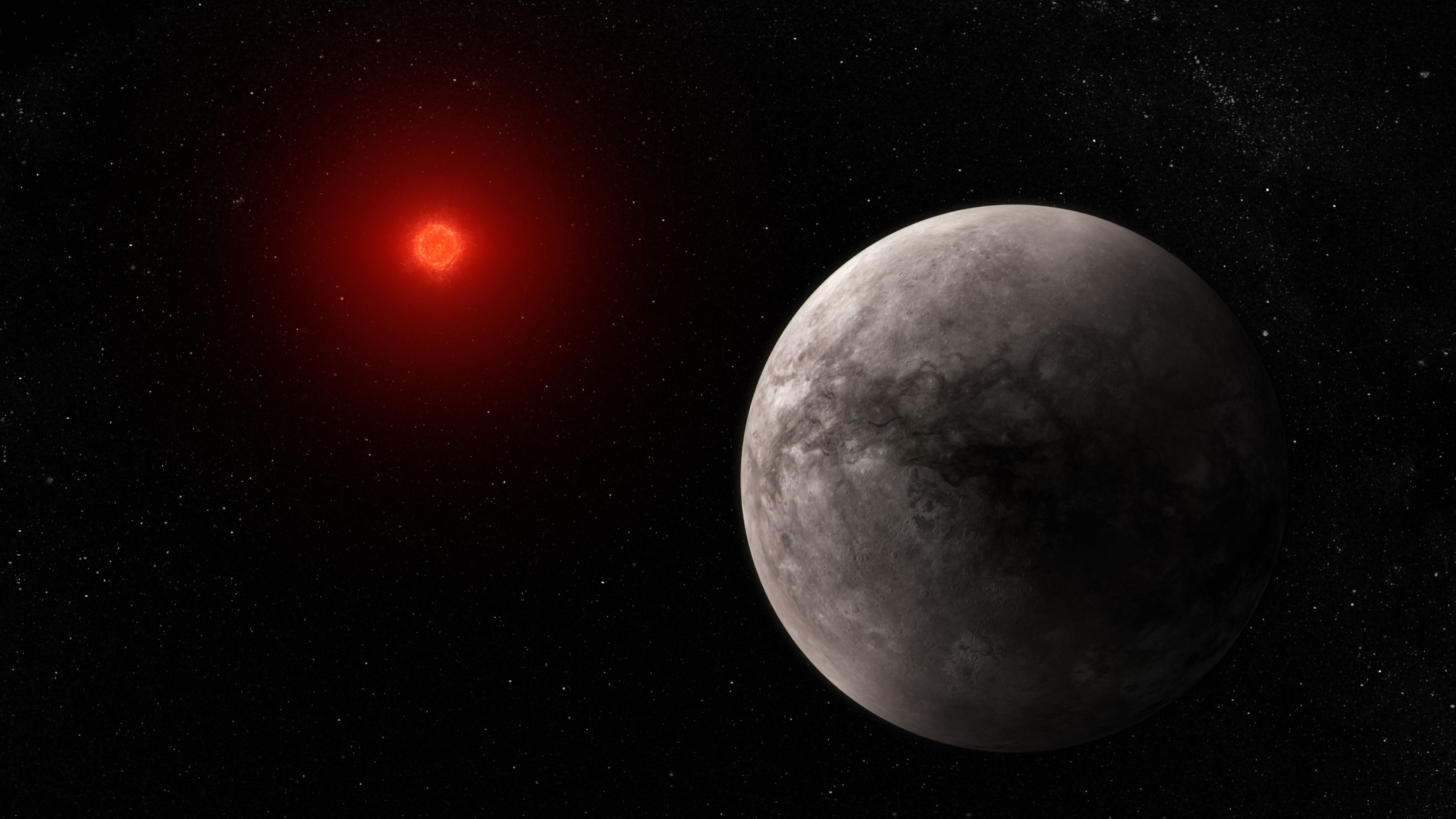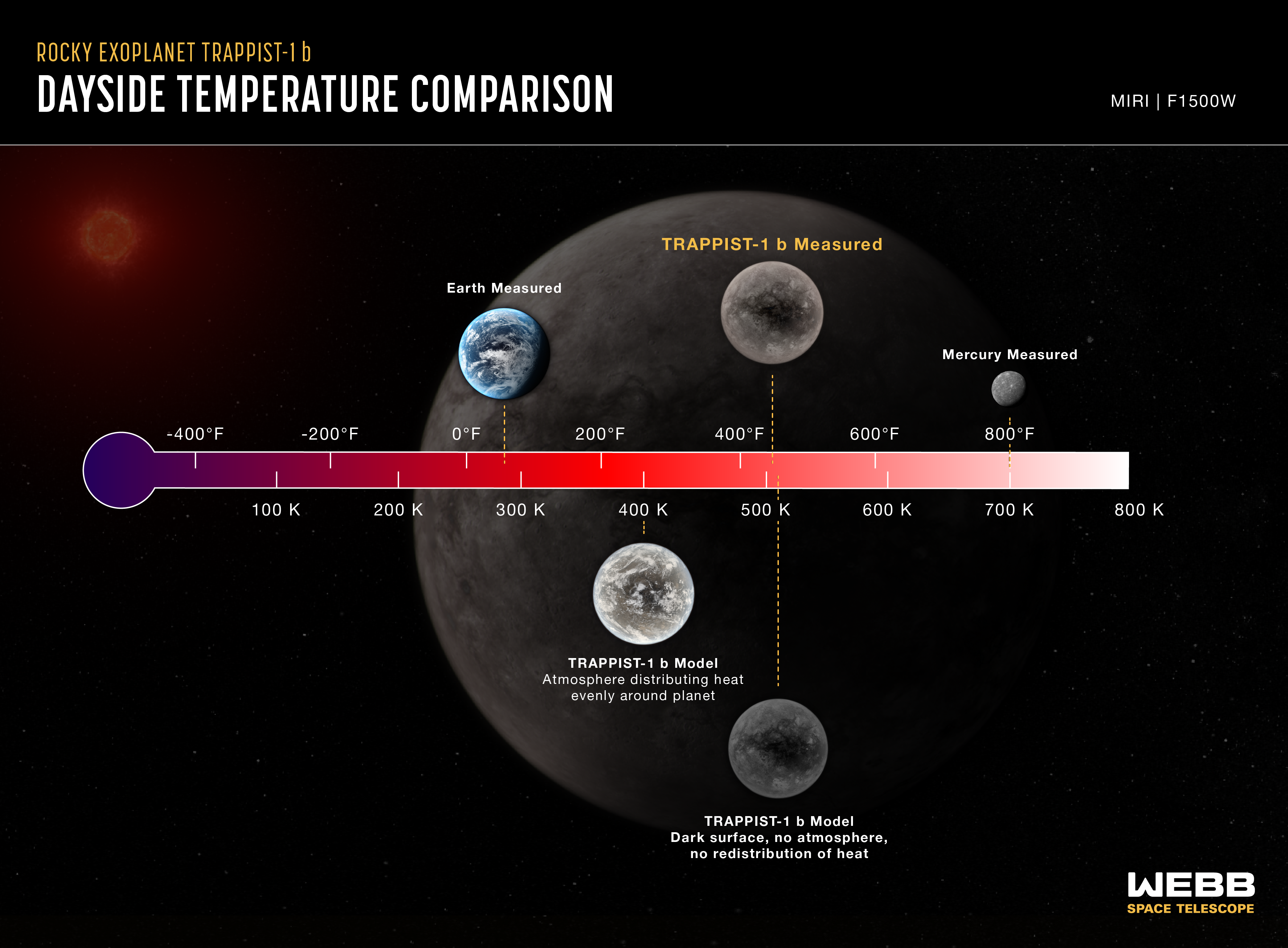1 min read
Rocky Exoplanet TRAPPIST-1 b (Secondary Eclipse Light Curve)

This light curve shows the change in brightness of the TRAPPIST-1 system as the innermost planet, TRAPPIST-1 b, moves behind the star. This phenomenon is known as a secondary eclipse.
Astronomers used Webb’s Mid-Infrared Instrument (MIRI) to measure the brightness of mid-infrared light. When the planet is beside the star, the light emitted by both the star and the dayside of the planet reach the telescope, and the system appears brighter. When the planet is behind the star, the light emitted by the planet is blocked and only the starlight reaches the telescope, causing the apparent brightness to decrease.
Astronomers can subtract the brightness of the star from the combined brightness of the star and planet to calculate how much infrared light is coming from the planet’s dayside. This is then used to calculate the dayside temperature.
The graph shows combined data from five separate observations made using MIRI’s F1500W filter, which only allows light with wavelengths ranging from 13.5-16.6 microns to pass through to the detectors. The blue squares are individual brightness measurements. The red circles show measurements that are “binned,” or averaged to make it easier to see the change over time. The decrease in brightness during the secondary eclipse is less than 0.1%. MIRI was able to detect changes as small as 0.027% (or 1 part in 3,700).
This is the first thermal emission observation of TRAPPIST-1 b, or any planet as small as Earth and as cool as the rocky planets in our solar system.
The observations are being repeated using a 12.8-micron filter in order to confirm the results and narrow down the interpretations.
Extended Description and Image Alt Text
Extended Description
Infographic titled “Rocky Exoplanet TRAPPIST-1 b Secondary Eclipse Light Curve, MIRI Time-Series Photometry (F1500W).”
The graphic has two parts. At the top is a diagram showing a planet moving behind its star (a secondary eclipse). Below the diagram is a graph showing the change in relative brightness of the star-planet system over time. The diagram and graph are aligned vertically to show the relationship between the geometry of the star-planet system as the planet orbits, and the measurements on the graph.
Diagram of Secondary Eclipse
At the center is a bright red-orange circle representing the star. A slightly arcuate gray line with an arrow pointing to the right represents a portion of the orbital path of the planet. Along the gray line, and on either side of the star, is a gray circle with a textured pattern. These represent the planet before (at left) and after (right) it moves behind the star. Both show a subtle brightening on the star-side of the planet. Along the line, in the middle of the star is an open circle with a dashed outline representing the position of the planet in the middle of the secondary eclipse, when it is behind the star. The star and planet are not to scale.
Graph
Below the secondary eclipse diagram is a graph of Brightness of 15-micron emitted light on the vertical y-axis versus Elapsed Time in hours on the horizontal x-axis.
Axes
The y-axis ranges from dimmer at the bottom to brighter at the top. There are no units or tick marks. The x-axis ranges from 0.00 hours at the origin on the left to 3.50 hours at the far right. There are labeled tick marks every 0.50 hours.
Data
The graph consists of 1,377 individual brightness measurements plotted as small solid blue squares, and 22 binned brightness measurements (averaged over 9.7-minute intervals) plotted as larger solid red circles. The points are not connected.
The individual brightness measurements (blue squares) show a broad scattering with a subtle but visible decrease in brightness in the middle of the graph, between about 1.5 and 2.25 hours.
The binned brightness measurements (red circles) show some slight variability between 0 and about 1.4 hours, and between 2.3 and 3.5 hours. The five measurements in the middle of the graph, between 1.5 and 2.2 hours, form a U shape.
There are three labels above the binned brightness measurements (red circles). The label in the center, above the dimmer, U-shaped section of data points, is labeled “Starlight only.” The flatter, brighter sets of measurements on the left and right sides of the graph are both labeled, “Starlight + planet dayside.”
Relationship between the Diagram and Graph
Vertical gray lines connect each of the three planet positions in the diagram to the corresponding portions of the light curve. From left to right: 1) Before the planet begins to move behind the star, the brightness is high and fairly level; 2) When the entire planet is behind the star and the brightness is at its lowest point (the center of the U-shaped valley); 3) When the planet has moved out from behind the star, the brightness has increased back to the level it was before the decrease.
Image Alt Text
Infographic titled “Rocky Exoplanet TRAPPIST-1 b Secondary Eclipse Light Curve” showing a diagram of a secondary eclipse and a graph of change in brightness over time.
About the Object
- R.A. PositionR.A. PositionRight ascension – analogous to longitude – is one component of an object's position.23h 06m 30s
- Dec. PositionDec. PositionDeclination – analogous to latitude – is one component of an object's position.-05d 02m 30s
- ConstellationConstellationOne of 88 recognized regions of the celestial sphere in which the object appears.Aquarius
- DistanceDistanceThe physical distance from Earth to the astronomical object. Distances within our solar system are usually measured in Astronomical Units (AU). Distances between stars are usually measured in light-years. Interstellar distances can also be measured in parsecs.40 light-years
- DimensionsDimensionsThe physical size of the object or the apparent angle it subtends on the sky.Diameter: 1.1 × Earth; Mass: 1.4 × Earth
About the Data
- Data DescriptionData DescriptionProposal: A description of the observations, their scientific justification, and the links to the data available in the science archive.
Science Team: The astronomers who planned the observations and analyzed the data. "PI" refers to the Principal Investigator.time-series photometry of secondary eclipse
- InstrumentInstrumentThe science instrument used to produce the data.MIRI
- Exposure DatesExposure DatesThe date(s) that the telescope made its observations and the total exposure time.2022: November 8, 12, 20, 24, and December 3
- FiltersFiltersThe camera filters that were used in the science observations.F1500W
- Object NameObject NameA name or catalog number that astronomers use to identify an astronomical object.TRAPPIST-1 b
- Object DescriptionObject DescriptionThe type of astronomical object.Rocky Exoplanet
- Release DateMarch 27, 2023
- Science ReleaseNASA’s Webb Measures the Temperature of a Rocky Exoplanet
- CreditIllustration: NASA, ESA, CSA, Joseph Olmsted (STScI); Science: Thomas Greene (NASA Ames), Taylor Bell (BAERI), Elsa Ducrot (CEA), Pierre-Olivier Lagage (CEA)
Related Images & Videos

Rocky Exoplanet TRAPPIST-1 b (Illustration)
This illustration shows what the hot rocky exoplanet TRAPPIST-1 b could look like based on this work. TRAPPIST-1 b, the innermost of seven known planets in the TRAPPIST-1 system, orbits its star at a distance of 0.011 AU, completing one circuit in just 1.51 Earth-days....

Rocky Exoplanet TRAPPIST-1 b (Dayside Temperature Comparison)
Comparison of the dayside temperature of TRAPPIST-1 b as measured using Webb’s Mid-Infrared Instrument (MIRI) to computer models showing what the temperature would be under various conditions. The models take into account the known properties of the system, including the...
Share
Details
Laura Betz
NASA’s Goddard Space Flight Center
Greenbelt, Maryland
laura.e.betz@nasa.gov
NASA, ESA, CSA, Joseph Olmsted (STScI)
Thomas Greene (NASA Ames), Taylor Bell (BAERI), Elsa Ducrot (CEA), Pierre-Olivier Lagage (CEA)






























